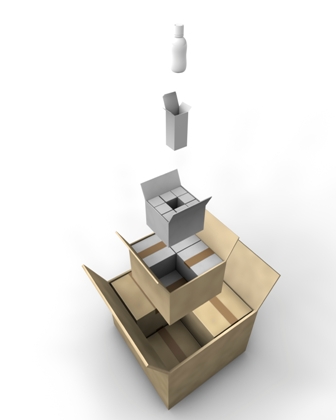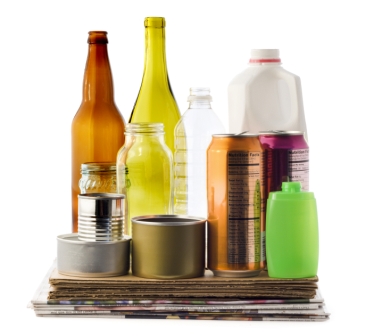|
Packaging Carbon Footprint Analysis
CleanMetrics now offers an integrated carbon footprint solution for the packaging industry. Using our standards-based life-cycle inventory database and our life-cycle assessment software tools, we can
provide reliable and high-quality life-cycle carbon footprint assessments for
all packaging products, materials and configurations.
Why Packaging Carbon Footprints?
 Packaging is obviously
required to protect virtually all products in transit and storage until they
reach consumers. But most of us have routinely experienced over-packaged
products and the inefficient use of packaging materials is an area that is ripe
for optimization. Recycling rates have generally plateaued in most countries,
and in any case end-of-life recycling alone cannot move us toward sustainable
packaging. Packaging systems must be designed with care, using the least amount
of materials/energy, maximizing recycled content, and increasing the potential
for reuse. Understanding the full life-cycle of these systems is critical for
optimizing their environmental performance. A life-cycle carbon footprint
analysis of packaging systems -- for both consumer and industrial products -- is
a crucial analytical tool that can help advance the cause of sustainable
packaging. Packaging is obviously
required to protect virtually all products in transit and storage until they
reach consumers. But most of us have routinely experienced over-packaged
products and the inefficient use of packaging materials is an area that is ripe
for optimization. Recycling rates have generally plateaued in most countries,
and in any case end-of-life recycling alone cannot move us toward sustainable
packaging. Packaging systems must be designed with care, using the least amount
of materials/energy, maximizing recycled content, and increasing the potential
for reuse. Understanding the full life-cycle of these systems is critical for
optimizing their environmental performance. A life-cycle carbon footprint
analysis of packaging systems -- for both consumer and industrial products -- is
a crucial analytical tool that can help advance the cause of sustainable
packaging.
What are Packaging Carbon Footprints?
The carbon footprint of a packaging system is the total amount of carbon dioxide
carbon dioxide (CO2) and other greenhouse gases emitted over the life cycle
of that product or service, expressed as kilograms of CO2
equivalents. This includes all greenhouse gases generated in the manufacture of
the raw materials, fabrication of the packaging system, transport of materials
and finished systems, the use phase including refurbishment and reuse, and
end-of-life disposal. This carbon footprint is often included in the analysis of
the larger product system that uses the packaging, but it can also be seen as a
distinct environmental performance metric that can be calculated and optimized
separately.
Why CleanMetrics?
 At CleanMetrics, we have worked on a broad range of commercial projects related
to packaging materials and systems, using life-cycle methods and focused on
carbon footprints. Our work has routinely included analyses of consumer product
packaging, bulk product containers/packages and secondary packaging
configurations that are produced using a range of virgin, recycled and
biodegradable materials -- including scenarios such as refurbishment, reuse,
recycling, and other end-of-life disposal. We understand that packaging systems
are more than just the materials used -- they are systems, with their own life-cycle
characteristics that must be modeled correctly. Our mission is to help your
business address the challenge of sustainable packaging with the best collection of
tools, data and expertise. At CleanMetrics, we have worked on a broad range of commercial projects related
to packaging materials and systems, using life-cycle methods and focused on
carbon footprints. Our work has routinely included analyses of consumer product
packaging, bulk product containers/packages and secondary packaging
configurations that are produced using a range of virgin, recycled and
biodegradable materials -- including scenarios such as refurbishment, reuse,
recycling, and other end-of-life disposal. We understand that packaging systems
are more than just the materials used -- they are systems, with their own life-cycle
characteristics that must be modeled correctly. Our mission is to help your
business address the challenge of sustainable packaging with the best collection of
tools, data and expertise.
Our life-cycle inventory database includes cradle-to-gate and/or unit process data for everything
needed to perform a complete life-cycle carbon
footprint analysis of packaging systems:
- Full range of virgin and recycled materials used in packaging systems --
including all types of plastics, glass, metals, fabrics, cardboard and
paper, as well as biodegradable fibers such as corn-based Ingeo and
sugarcane-based bagasse.
- Transportation, warehousing,
fuels, and electricity by grid regions.
- All common waste disposal methods -- such as landfill, incineration, compost,
reuse and recycling -- including energy recovery options.
The database is fully integrated with our life-cycle
assessment software tools and can be easily customized for your specific
application. We are continually adding data for more products/processes to the
database. We also offer a low-cost rapid research option to add data for
specific products or processes that you may need for your application.
Our Solutions
We offer a range of solutions depending on your needs and in-house expertise.
- For organizations with internal expertise in life-cycle assessment and product
carbon footprints, we can license our software products with integrated
life-cycle inventory database. We can also license our
database separately if
you have other means of performing the analyses.
- For organizations that are looking for a turn-key solution, we can use our
software tools, database and technical expertise to provide a complete
end-to-end solution
and deliver analytical results tailored for your specific business needs.
You can use our solutions in a variety of ways:
- Provide
consumer information such as product carbon labels or purchasing guides.
- Provide investor information such as corporate environmental reports.
- Identify hot spots in your supply and delivery chain, and make your
product/service more carbon efficient on a life-cycle basis.
© Copyright 2007-2011 by CleanMetrics Corp. All rights reserved.
CleanMetrics, CargoScope, CarbonScope, BuildingScope, CarbonScopeData,
FoodCarbonScope, Deep Carbon Footprinting, and MetaFlowScope are trademarks of CleanMetrics Corp. |
|
